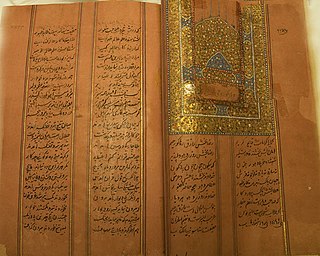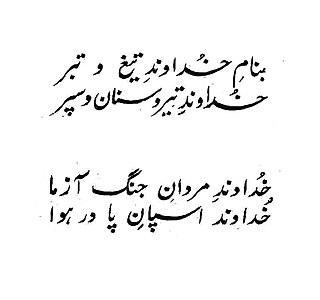
Guru Gobind Singh was the tenth and last human Sikh Guru. He was a warrior, poet, and philosopher. In 1675, at the age of nine he was formally installed as the leader of the Sikhs after his father Guru Tegh Bahadur was executed by Emperor Aurangzeb. His father was the ninth Sikh Guru. His four biological sons died during his lifetime – two in battle and two executed by the Mughal governor Wazir Khan.

The Guru Granth Sahib is the central holy religious scripture of Sikhism, regarded by Sikhs as the final, sovereign and eternal Guru following the lineage of the ten human gurus of the religion. The Adi Granth, its first rendition, was compiled by the fifth guru, Guru Arjan (1564–1606). Its compilation was completed on 29 August 1604 and first installed inside the Golden Temple in Amritsar on 1 September 1604. Baba Buddha was appointed the first Granthi of the Golden Temple. Shortly afterwards Guru Hargobind added Ramkali Ki Vaar. Later, Guru Gobind Singh, the tenth Sikh guru, added hymns of Guru Tegh Bahadur to the Adi Granth and affirmed the text as his successor. This second rendition became known as the Guru Granth Sahib and is also sometimes referred to as the Adi Granth.
The following outline is provides an overview of Sikhism, or Sikhi.

The Dasam Granth is a collection of various poetic compositions attributed to Guru Gobind Singh. The text enjoyed an equal status with the Adi Granth, or Guru Granth Sahib, in the eighteenth and nineteenth centuries and were installed side by side on the same platform. The Dasam Granth lost favor during the colonial period when reformist Singh Sabha Movement scholars couldn't contextualize the reworkings of Puranic stories or the vast collection of 'Tales of Deceit' Sri Charitropakhyan.

The Zafarnāma was a spiritual victory letter sent by Guru Gobind Singh in 1705 to the Mughal Emperor of India, Aurangzeb, after the Battle of Chamkaur.

Rehras Sahib, commonly known as So dar Rehras, is the daily evening prayer of the Sikhs and is part of Nitnem. It includes hymns from Guru Granth Sahib Ji and Dasam Granth Ji.

The Nihang or Akali, also known as Dal Khalsa, is an armed Sikh warrior order originating in the Indian subcontinent. Nihangs are believed to have originated either from Fateh Singh and the attire he wore or from the "Akal Sena" started by Guru Hargobind. Early Sikh military history was dominated by the Nihang, known for their victories where they were heavily outnumbered. Traditionally known for their bravery and ruthlessness in the battlefield, the Nihang once formed the irregular guerrilla squads of the armed forces of the Sikh Empire, the Sikh Khalsa Army.

Dal Khalsa was the name of the combined military forces of 11 Sikh misls that operated in the 18th century (1735–1799) in the Punjab region. The military force was established by Nawab Kapur Singh in the mid 1730s.

Bhai Mani Singh was an 18th-century Sikh scholar and martyr. He was a childhood companion of Guru Gobind Singh and took the vows of Sikhism when the Guru inaugurated the Khalsa in March 1699. Soon after that, the Guru sent him to Amritsar to take charge of Harmandir Sahib, which had been without a custodian since 1696. He took control and steered the course of Sikh destiny at a critical stage in Sikh history. He was also a teacher of the Gianian Bunga, later becoming known as the "Amritsari Taksal", currently located in Sato Ki Gali.
Daya Singh was one of the Panj Pyare, the first five Sikhs to be initiated into the Khalsa order in 17th-century India.

The principal Sikh scripture is the Adi Granth, more commonly called the Guru Granth Sahib. The second most important scripture of the Sikhs is the Dasam Granth. Both of these consist of text which was written or authorised by the Sikh Gurus.
Rahon is a city and a municipal council in the district Shaheed Bhagat Singh Nagar of the Indian state of Punjab. Rahon is in Doaba region of Punjab. Doaba also known as Bist Doab, is the region of Punjab, India that lies between the Beas River and the Sutlej River. A famous battle was fought here between Sikhs and Mughals i.e Battle of Rahon (1710).
The Battle of Bhangani was fought between Guru Gobind Singh's army and Bhim Chand (Kahlur) of Bilaspur on 18 September 1686 or 1688, at Bhangani near Paonta Sahib. An alliance of Rajput Rajas of the Shivalik Hills participated in the engagement on behalf of Bhim Chand of Bilaspur State's side, including the states of Garhwal and Kangra. It was the first battle Guru Gobind Singh, the tenth Sikh Guru, fought at the age of 19.
The Battle of Nadaun, alternatively known as Hussaini Yudh, was fought in the late 17th century between a Kahlur army under Chandel ruler Bhim Chand and forces of the Mughal Empire under governors like Hussaini Khan, Wazir Khan and Alif Khan, etc. The Mughals were additionally supported by the kings of Kangra and Bijharwal. The reason for the conflict was that if the Chandels did not pay taxes then other Hills Rajput kings would not pay taxes because everyone followed and obeyed them. In the battle, the Mughals and Kangra were defeated and driven out into the Vyas River by Bhim Chand while Alif Khan and his warriors fled away.
The Battle of Anandpur was fought at Anandpur, between the armies of the Sikh Guru Gobind Singh and the Mughal forces aided by the Nawab of Bahawalpur state, Rajas of the Sivalik Hills.

Hikaaitaan or Hikāyatān is a title given to the semi-legendary set of 11 tales, composed in the Gurmukhi/Persian vernacular, whose authorship is traditionally attributed to Guru Gobind Singh. It is the last composition of the second scripture of Sikhs, Dasam Granth, and some believe it to be appended to Zafarnamah—the letter to Mughal emperor Aurangzeb.

Shabad Hazare, also known as Sabad Patshahi 10, under the title Shabad, are ten religious hymns composed by Guru Gobind Singh that are present in Dasam Granth. These hymns have comments on ritualistic practices in Sanyas, Jogis and Bairagis, and also against any form of idolatry, human or deity worship.
Lohgarh is a historic town in Bilaspur tehsil of Yamunanagar district of Haryana in India. It was the capital of the Sikh state under Baba Banda Singh Bahadur from 1710 to 1716.

Rama, known as Ram Avatar or Raja Ram, is considered an important figure in Sikhism, due to his inclusion as one among the 24 incarnations of Vishnu in the Chaubis Avtar, a composition in the Dasam Granth traditionally and historically attributed to Guru Gobind Singh. The discussion of Rama and Krishna is the most extensive in this section of the secondary Sikh scripture. The composition is martial, stating that the avatar of Vishnu appears in the world to restore good and defeat evil, but asserts that these avatars are not God, but agents of the God. God is beyond birth and death. The famous Savaiya and Dohra from the Rehras Sahib, read daily be devout Sikhs, comes from Ram Avtar Bani.

Fatehnama, also known as Namah-i-Guru Gobind Singh or the Jangnamah is a Persian composition attributed to Guru Gobind Singh. It was contained within the Dasam Granth.












